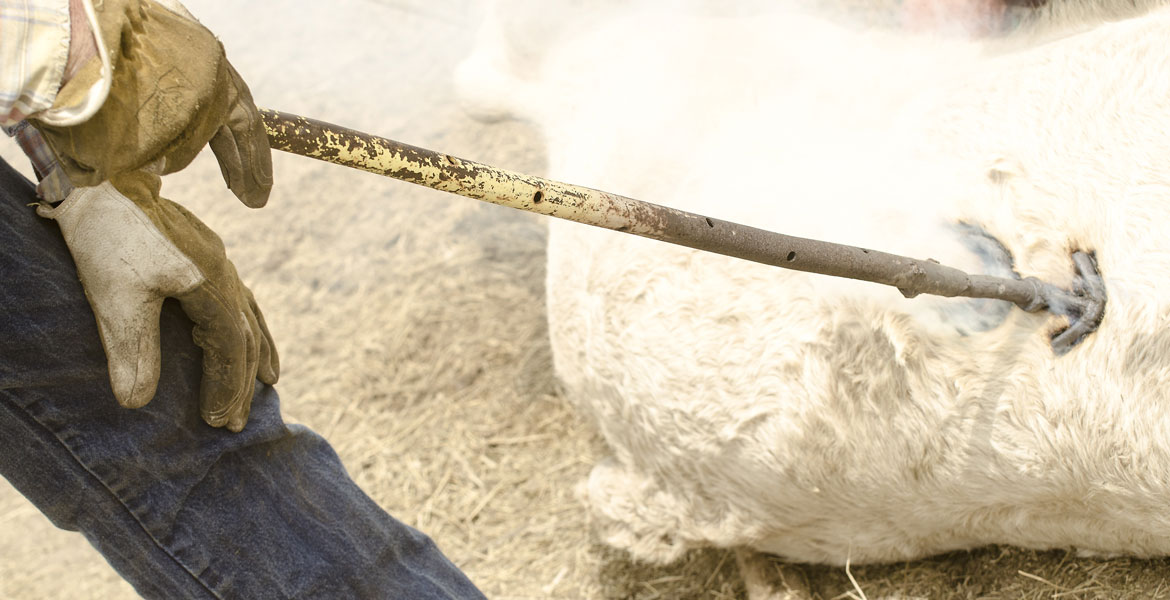
Branding Cattle: Animal Welfare Considerations, Legal Implications and Alternatives
Monday, April 27, 2020
The tradition of gathering cattle to perform processing procedures is of historic and cultural importance, particularly in the western United States. The long standing practice of fire branding is more recently giving way to electric and freeze branding. Branding identifies cattle who are free roaming on the range, serves to deter cattle rustling, and helps to return rustled animals to their rightful owners.
Unfortunately, cattle rustling is also a western American tradition. Recent numbers indicate that an average of 2,500 to 3,000 head of cattle are stolen from Oklahoma producers annually. The direct costs to producers and the state via law enforcement and other efforts are tremendous. Currently, branding is voluntary and brand inspection is not required in Oklahoma. A user-friendly summary of branding laws in Oklahoma can be found here: Livestock Branding in Oklahoma.
Although time-honored, branding does have some recognized drawbacks, including costly damage to the hide and concerns for animal welfare from this painful procedure. There have been a handful of studies looking at pain caused by the various forms of branding. Here is a summary of the findings:
- Hot-iron branding is more painful than freeze branding and both were more painful than sham branding (restraint and pressure with a cold branding iron)
- Hot-iron branding is most painful at the time of brand placement, while freeze branding appears most painful 15 to 30 minutes after the procedure
- Hot-iron branding causes more inflammation than freeze branding
- Hot-iron brands may stay painful for at least 8 weeks, evidenced by avoidance behavior of the cattle. This study also showed that a dose of the anti-inflammatory drug flunixin did not mitigate this.
- Another study of hot-iron branding did show that an injection of the anti-inflammatory drug meloxicam may help to reduce the associated pain. (Author’s comment: we do not have injectable meloxicam available for use in cattle, however, we do often use meloxicam tablets provided in a gel bolus. There may be a place for this to mitigate the pain of branding, however, it would likely need to be administered perhaps a day ahead of the branding, on the day of branding, and perhaps for a time after, but this has not been evaluated in the research. This would be a great topic to bring up with your veterinarian.)
If branding is continued on an operation, it appears that freeze branding would be preferred except in breeds whose hair coat will not allow visibility of white hairs. There are many alternatives to branding in states where branding is not required. Advantages of these include improved traceability and lower pain potential. Although the programs have been in place for many years, in recent years, the USDA has increased efforts to push for more permanent, individual identification of cattle. The goal of this push is to improve traceability for cattle that develop certain diseases of economic significance. Think in terms of our current COVID-19 situation – how easy would it have been to track those cases if we were not simply relying on people’s memories of who they recently contacted?
The USDA prefers RFID tags as the identification method above all other options. Many herds are integrating these into their program as they are semi-permanent and allow for efficient traceability. They are also a tremendous asset to the herd in terms of ease of record keeping. Metal clip tags, breed tattoos, RFID boluses, and microchips (placed in non-edible tissue) are also forms of individual, permanent or semi-permanent identification. Emerging technologies include various GPS devices for cattle. Flop or plastic tags are easily lost or removed and are very weak in terms of traceability. Their visibility is their major advantage and they are great if used in combination with another more permanent method.
In summary, USDA RFID tags are the preferred method of permanent identification in cattle above all other forms, including branding. If branding is to be used on a ranch operation, freeze branding is preferred and provides a more visible identification to supplement the RFID tag.
An excellent resource on proper freeze branding of cattle can be found at: Freeze Branding Cattle.
Information for this article was, in part, derived from a summary provided by the American Association of Bovine Practitioners Animal Welfare Committee, published in February 2020.
References for the research studies presented are available upon request.
About the author: Meredyth Jones, DVM, MS, DACVIM, is an associate professor in food animal medicine and surgery at the Oklahoma State University College of Veterinary Medicine. She is a diplomate of the American College of Veterinary Internal Medicine (Large Animal).
Image by Lisa Johnson from Pixabay
